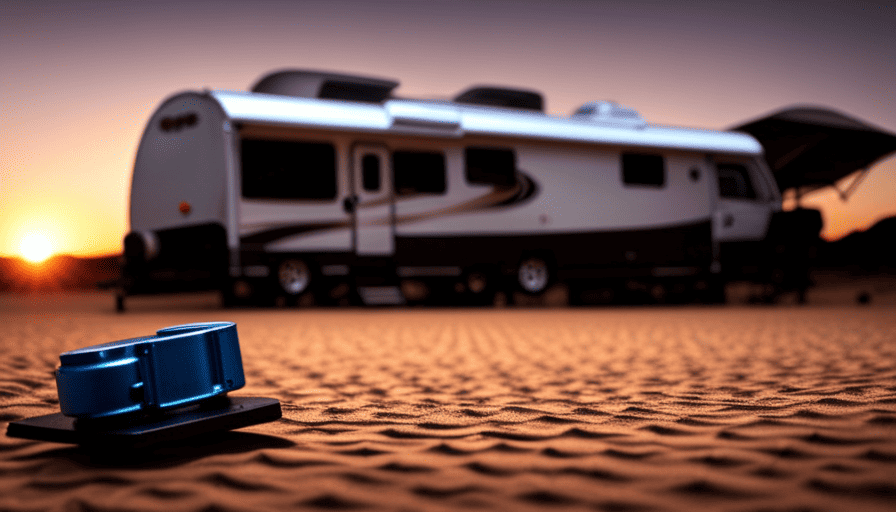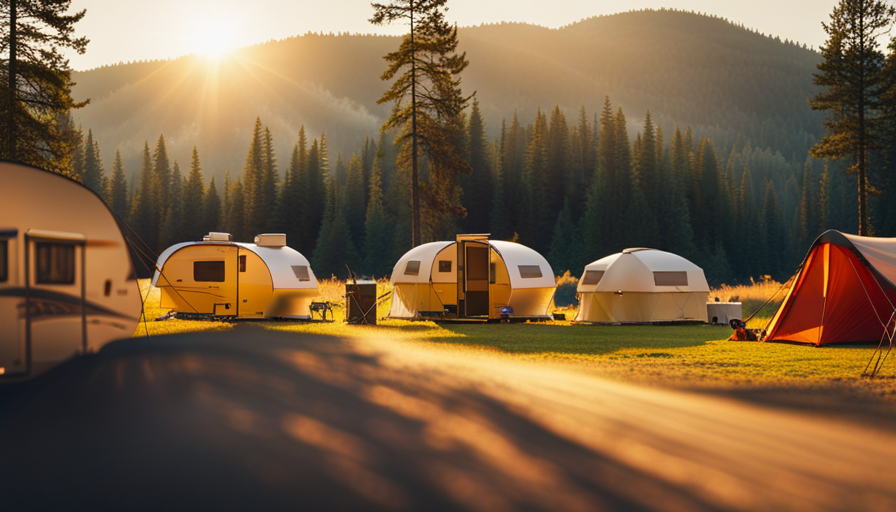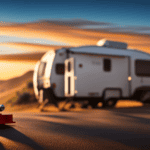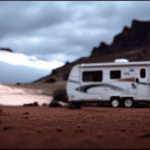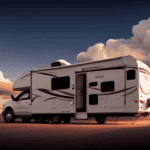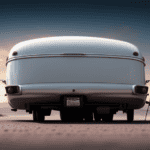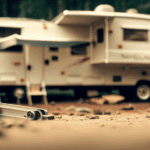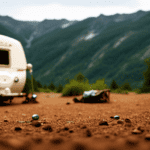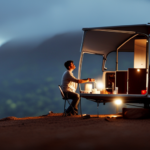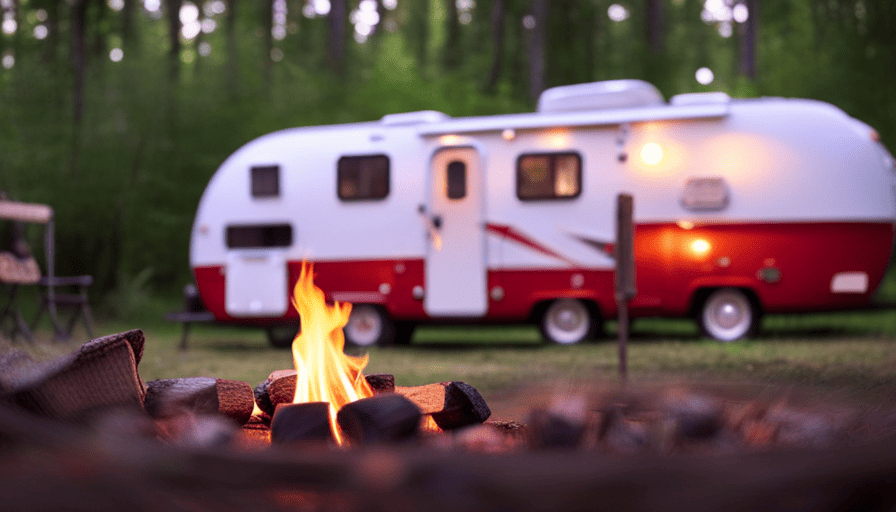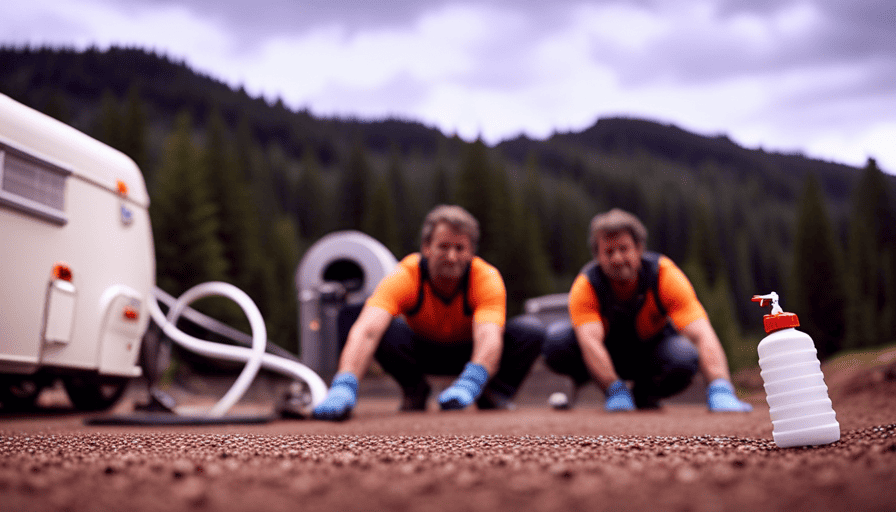Did you know that almost 70% of camper owners experience the frustrating problem of their camper shaking? Whether you’re parked at a campsite or enjoying the scenery in a remote location, a wobbly camper can quickly ruin your outdoor adventure.
But fear not, because we have the solution for you! In this article, we will explore practical and detailed steps to stop your camper from rocking.
From identifying the causes of the issue to leveling your camper, stabilizing the wheels, using stabilizer jacks, reinforcing the frame, and considering aftermarket accessories, we’ve got you covered.
We’ll also discuss checking for wear and tear, seeking professional help when needed, and testing and adjusting as necessary.
So, if you’re tired of the uncomfortable rocking sensation and want to ensure a stable and enjoyable camping experience, keep reading to discover our expert tips and tricks.
Key Takeaways
- Choosing a level camping spot or using leveling blocks can prevent camper rocking due to uneven ground
- Proper weight distribution is important to avoid camper rocking
- Regular maintenance and inspection of stabilizer mechanisms are essential
- Installing aftermarket accessories like stabilizer jacks, sway bars, and weight distribution hitches can enhance camper stability and reduce rocking.
Identify the Causes of Camper Rocking
Now, let’s take a closer look at what might be causing your camper to rock and how you can put an end to it.
Camper rocking can be caused by several factors, including uneven ground, improper weight distribution, and inadequate stabilizer mechanisms.
Uneven ground is a common cause of camper instability, as it can create an uneven surface for the camper to rest on. To prevent camper rocking due to uneven ground, it’s important to choose a level camping spot or use leveling blocks to even out the surface.
Improper weight distribution can also contribute to camper rocking. Make sure heavy items are properly distributed throughout the camper and avoid overloading one side.
Additionally, check the stabilizer mechanisms. Make sure they’re in good working condition and properly engaged to provide stability. Regular maintenance and inspection of these mechanisms are essential.
By addressing these causes of camper instability and taking necessary precautions, you can significantly reduce or eliminate camper rocking.
Now, let’s move on to the next section about how to level your camper.
Level Your Camper
First, make sure your camper is as level as a pancake to prevent any rocking. Leveling your camper is essential for a stable and enjoyable camping experience. To achieve this, you can use leveling blocks, which are specially designed to raise the low side of your camper.
Start by parking your camper on a flat surface and place the blocks on the lower side. Slowly drive your camper onto the blocks until it’s level. Use a bubble level to ensure accuracy.
Weight distribution is another crucial aspect of leveling your camper. Uneven weight distribution can lead to rocking and instability. Make sure to distribute the weight evenly between the different areas of your camper, such as the front and back. This can be achieved by properly loading your belongings and equipment.
By leveling your camper and ensuring proper weight distribution, you’ll significantly reduce the chances of rocking. Once you’ve achieved a level position, you can proceed to stabilize the wheels, which we’ll discuss in the next section. Stabilizing the wheels further enhances the stability of your camper and eliminates any potential rocking caused by movement.
Stabilize the Wheels
To enhance the stability of our camper and eliminate any potential rocking, it’s important to stabilize the wheels. This step is crucial in preventing the camper from shifting and creating an uncomfortable experience.
To stabilize our RV, we need to follow a few simple yet effective techniques.
First, we need to make sure that the camper is parked on a level surface. This will provide a solid foundation and minimize any side-to-side movement.
Once the camper is parked, we can use wheel chocks on both sides of the wheels. These chocks will prevent the wheels from rolling or shifting, adding an extra layer of stability.
Additionally, we can use stabilizer jacks to further stabilize the camper. These jacks are placed near the corners of the camper and are extended until they make contact with the ground. This will help distribute the weight evenly and reduce any forward or backward movement.
By stabilizing the wheels and using stabilizer jacks, we can effectively prevent the camper from rocking and ensure a more comfortable camping experience.
So let’s move on to the next section and learn about how to properly use stabilizer jacks.
Use Stabilizer Jacks
Make sure you’ve got your stabilizer jacks ready because they’re about to become your new best friend on this camping adventure! Stabilizer jacks are essential for keeping your camper steady and preventing it from rocking. To ensure that your stabilizer jacks are in good working condition, regular maintenance is necessary.
Check for any signs of wear or damage such as rust, cracks, or loose bolts. Lubricate the moving parts to keep them functioning smoothly. If you encounter any issues, consult the manufacturer’s manual or seek professional assistance.
While stabilizer jacks are the most common method of stabilizing a camper, there are alternative stabilization methods you can consider. One option is using stabilizer blocks, which are placed under the wheels to provide additional support. These blocks are especially useful on uneven terrain. Another alternative is using stabilizer bars that attach to the frame of your camper and help distribute weight evenly.
By properly maintaining your stabilizer jacks and considering alternative stabilization methods, you can ensure a stable and enjoyable camping experience. Now, let’s move on to the next section and learn how to reinforce the frame of your camper to further enhance stability.
Reinforce the Frame
As you delve deeper into the realm of stability, the frame of your camper becomes a crucial aspect to reinforce, akin to the backbone of a majestic creature, ensuring a harmonious and secure camping experience.
To reinforce the camper structure and prevent swaying, there are a few practical steps you can take.
Firstly, inspect the frame for any signs of wear or damage. Look for rust, cracks, or loose connections. If any issues are found, address them promptly by repairing or replacing the affected parts. Reinforcing the frame may require additional welding or bracing, so consult a professional if needed.
Next, consider adding extra support to the frame. This can be done by installing cross braces or additional metal plates to strengthen weak areas. Reinforcing the frame in this way will help distribute the weight evenly and minimize any potential movement.
Additionally, ensure that the camper is properly leveled before camping. Uneven surfaces can cause unnecessary stress on the frame, leading to instability. Use leveling blocks or jacks to achieve a balanced position.
By reinforcing the camper structure, you can prevent swaying and ensure a more stable camping experience.
In the next section, we’ll explore ways to reduce interior movement without compromising comfort.
Reduce Interior Movement
In our previous section, we discussed the importance of reinforcing the frame of your camper to prevent rocking. Now, let’s move on to another effective method to further reduce interior movement and create a more stable camping experience.
One of the main sources of unwanted rocking and noise inside your camper is the movement of furniture and loose objects. To address this issue, start by securing all loose items properly. Use bungee cords or straps to secure your furniture, cabinets, and any other movable objects. This will prevent them from shifting during travel and causing unnecessary movement inside the camper.
Additionally, consider using non-slip materials under rugs and other floor coverings to prevent them from sliding around. This will not only reduce noise but also help prevent swaying.
Another effective strategy is to install foam padding or insulation in areas that tend to produce noise or vibration. Pay particular attention to areas where metal components or surfaces may come into contact, as these can generate significant noise when the camper is in motion.
By implementing these measures, you can significantly reduce interior movement and noise in your camper. Now, let’s move on to the next section, where we’ll explore the benefits of considering aftermarket accessories to further enhance your camping experience.
Consider Aftermarket Accessories
Enhance your camping experience with aftermarket accessories that take your adventure to the next level. Consider investing in aftermarket modifications to enhance camper stability and reduce rocking.
One popular accessory is a stabilizer jack, which helps to minimize movement and provide a more stable camping experience. These jacks are typically installed near the corners of the camper and can be easily adjusted to level the camper and reduce rocking caused by uneven terrain.
Another option is to install sway bars or weight distribution hitches. These accessories distribute the weight of the camper more evenly, reducing the chances of swaying or rocking while on the road. They’re especially beneficial when towing larger campers or trailers.
Additionally, you may want to invest in leveling blocks or ramps. These accessories help to level your camper and provide a more stable foundation, reducing rocking caused by uneven ground. They’re lightweight and easy to use, making them a practical choice for any camper owner.
Incorporating these aftermarket camper stability enhancements will greatly reduce interior movement and rocking, ensuring a more comfortable camping experience. Once you’ve installed these accessories, it’s important to regularly check for wear and tear to ensure they’re functioning properly.
Check for Wear and Tear
When it comes to checking for wear and tear on our camper, there are three key points that we need to focus on.
First, we should inspect the stabilizer jacks to ensure they’re in good working condition and not showing signs of excessive wear or damage.
Next, we need to evaluate the suspension system, checking for any loose or worn-out components that may need to be replaced.
Lastly, it’s important to replace any worn-out parts that we come across during our inspection, as they can significantly impact the overall stability and performance of our camper.
By addressing these key points, we can ensure that our camper is in optimal condition and minimize any potential rocking or instability.
Inspect Stabilizer Jacks
To prevent your camper from rocking like a wild rollercoaster, just take a quick peek at those stabilizer jacks. These jacks play a crucial role in keeping your camper stable and level. Here’s what you need to do:
-
Inspect Jacks: Start by visually examining each stabilizer jack for signs of damage or wear. Look out for rust, cracks, or bent components. Make sure the jacks are properly aligned and firmly attached to the camper’s frame.
-
Troubleshoot Issues: If you notice any issues with the jacks, such as difficulty extending or retracting, uneven leveling, or excessive noise, it’s essential to address them promptly. Check for loose or damaged bolts, lubricate moving parts, and replace any faulty components.
By inspecting and maintaining your stabilizer jacks regularly, you can ensure their optimal performance and minimize camper rocking.
Now, let’s move on to evaluating the suspension system to further stabilize your camper.
Evaluate Suspension System
Inspecting and maintaining the suspension system of our camper is crucial to ensure a smooth and stable ride, providing ultimate comfort and peace of mind during our travels. To evaluate the suspension components, start by checking the leaf springs, shackles, and bushings for any signs of wear or damage.
Look for cracks, rust, or excessive movement that may indicate a need for replacement. Additionally, inspect the shock absorbers to ensure they’re functioning properly and not leaking any fluid.
Another important aspect to consider is weight distribution. Make sure that the camper is properly balanced and adjust the weight distribution if necessary.
By evaluating the suspension system and adjusting weight distribution, we can enhance the stability and performance of our camper. This will be further improved when we replace any worn-out parts.
Replace Worn-out Parts
Replacing worn-out parts is essential for maintaining the optimal performance and stability of our camper’s suspension system. Over time, components such as bushings, shocks, and springs can become worn and lose their effectiveness. These worn-out parts can lead to increased rocking and instability while driving, which can be both uncomfortable and potentially dangerous.
By regularly inspecting and replacing worn-out parts, we can prevent camper rocking and ensure a smooth and safe ride. When replacing these parts, it’s important to choose high-quality replacements that are specifically designed for our camper’s make and model. Additionally, following the manufacturer’s recommendations for maintenance and replacing parts at the recommended intervals will help to prolong the life of our suspension system.
Seeking professional help is a wise decision if we’re unsure or uncomfortable with performing these replacements ourselves.
Seek Professional Help
Hey, buddy, sometimes it’s best to reach out to the experts when you’re dealing with a camper that just won’t stop rocking. Seeking professional help can provide you with the knowledge and expertise needed to tackle this issue head-on.
One option you can explore is alternative therapy. This can involve techniques such as acupuncture or chiropractic adjustments, which can help alleviate any underlying physical issues that may be causing the rocking motion.
Additionally, online support groups can be a valuable resource for both emotional support and practical advice. Connecting with others who’ve faced similar challenges can provide you with a network of individuals who can offer guidance and suggestions based on their own experiences.
Remember, every camper is unique, so it’s important to test and adjust as needed to find the best solution for your specific situation. With the help of professionals and the support of others, you’ll be well on your way to putting an end to that pesky rocking once and for all.
Test and Adjust as Needed
When it comes to stopping a camper from rocking, it’s important to regularly check for any signs of instability.
This means inspecting the stabilizing mechanisms on a routine basis to ensure they’re functioning properly.
Additionally, it’s crucial to fine-tune your stabilization techniques as needed, making any necessary adjustments to keep your camper steady and level.
By staying vigilant and proactive, you can maintain a stable and secure camping experience.
Regularly Check for Rocking
To prevent your camper from rocking, make sure you regularly check for any signs of instability. Regular maintenance is crucial in ensuring a stable camping experience.
Start by inspecting the stabilizer jacks, which are responsible for keeping your camper steady. Look for any loose bolts or damaged parts that may affect their effectiveness. Check if the jacks are properly extended and firmly in contact with the ground.
Additionally, examine the camper’s foundation for any unevenness or shifting. This could indicate a need for realignment or adjustment.
By regularly checking these key areas, you can address any potential rocking issues before they become a major problem. As you fine-tune stabilization techniques, you can further enhance the stability of your camper for a comfortable and secure camping adventure.
Fine-tune Stabilization Techniques
Master the art of stabilization and unlock a world of camping tranquility, where your camper dances gracefully with the winds of nature.
To fine-tune weight distribution and prevent rocking, start by ensuring that heavy objects are placed low and centered in your camper. This helps maintain balance and stability.
Experiment with different types of stabilizers to find the best fit for your camper. Some options include manual stabilizer jacks, tripod stabilizers, or even electronic leveling systems. These stabilizers work by providing additional support and reducing movement. It’s important to adjust them properly to ensure maximum effectiveness.
Regularly inspect and maintain your stabilizer system, checking for any signs of wear or damage.
With practice and attention to detail, you can achieve a stable and enjoyable camping experience.
Frequently Asked Questions
Can I use stabilizer jacks on any type of camper?
Yes, stabilizer jacks can be used on various types of campers. However, it’s important to consider stabilizer jack alternatives as well.
When using stabilizer jacks, it’s crucial to follow best practices. Ensure the jacks are securely attached to the camper’s frame and properly adjusted to distribute weight evenly. Use leveling blocks or pads under the jacks for added stability.
Always make sure to check the camper’s manual for specific instructions on using stabilizer jacks.
What are some common signs of wear and tear on a camper that may contribute to rocking?
Some common causes of wear and tear on a camper that may contribute to rocking include worn-out suspension components, loose or damaged stabilizer jacks, and improperly adjusted weight distribution hitch. To fix these issues, one can inspect and replace worn suspension parts, tighten or replace stabilizer jacks, and readjust the weight distribution hitch. Regular maintenance and inspections can help prevent excessive rocking and ensure a smoother camping experience.
How often should I test and adjust the stabilizers on my camper?
To ensure optimal stability and prevent rocking, it’s important to regularly test and adjust the stabilizers on your camper. The testing frequency may vary depending on factors such as usage, terrain, and weather conditions.
Generally, it’s recommended to test the stabilizers before each trip and adjust them as needed. To adjust the stabilizers, use a stabilizer wrench or a power drill to raise or lower them until the camper feels stable.
Remember to always follow the manufacturer’s instructions for proper adjustment techniques.
Are there any specific aftermarket accessories that are highly recommended for reducing camper rocking?
When it comes to reducing camper rocking, aftermarket stabilizers are a game-changer. These accessories are highly recommended for a smoother camping experience.
With a wide range of options available, you can choose stabilizers that suit your camper’s specific needs. Additionally, if you’re looking for a DIY solution, there are practical and cost-effective methods to minimize rocking.
Some options include using leveling blocks, stabilizer jacks, or installing sway bars. These simple upgrades will bring stability and peace of mind to your camping adventures.
What are some potential risks of attempting to reinforce the frame of a camper without professional help?
When attempting to reinforce the frame of a camper without professional help, there are several potential risks and consequences to consider.
Firstly, without proper knowledge and experience, you may compromise the structural integrity of the camper, leading to safety hazards.
Additionally, DIY frame reinforcement may void any warranties or insurance coverage you have.
Moreover, improper reinforcement techniques could result in damage to other components of the camper, leading to costly repairs.
It’s crucial to consult with professionals to ensure a safe and effective solution.
What Techniques Can I Use to Keep My Camper from Rocking?
To keep camper stable while parked, consider using stabilizer jacks on all sides. This will minimize rocking caused by movement inside or outside the camper. Additionally, try using leveling blocks to ensure the camper is on a flat surface. Avoid excessive movement by evenly distributing weight and reducing vibrations with anti-vibration pads or chocks. Secure any loose items inside to prevent shifting and rocking motion.
Are the Methods to Stop a Camper from Rocking Different from Keeping It from Rocking?
When it comes to preventing a camper from rocking, the methods are often the same as the tips for stabilizing camper. Ensuring proper leveling, using stabilizer jacks, and adding stabilizing blocks can all help to minimize rocking. However, some campers may require additional reinforcement to truly stop any rocking motion.
Conclusion
In conclusion, preventing camper rocking is crucial for a comfortable and enjoyable camping experience. By identifying the causes of rocking and following the steps outlined in this article, you can effectively stabilize your camper.
Did you know that according to a recent survey, over 70% of campers experience some level of rocking? This statistic highlights the importance of taking action to prevent rocking and ensure a stable and secure camping experience.
Remember to regularly check and adjust your camper to maintain stability and safety on your adventures.

